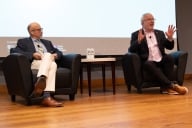You have /5 articles left.
Sign up for a free account or log in.
A recent patent application by Khan Academy is raising questions about whether teaching methods can be patented, but patent law experts see the move as an influential player fortifying its position in the market. Ultimately, the U.S. Patent and Trademark Office will have the last say.
The online education platform, which primarily focuses on K-12 education and test preparation, in March applied for a patent for “systems and methods for split testing educational videos” -- in other words, the method of showing students two different clips and determining which one is more effective at teaching a certain topic.
News of the patent application, first reported by Slashdot, was met with confusion from ed-tech analysts over the holidays. Why, they asked, would Khan Academy, a nonprofit whose mission is to “provide a free, world‑class education for anyone, anywhere” patent what effectively amounts to A/B testing in education? How would it affect other online education providers? Most importantly, could it even be patented?
Intellectual property and patent law experts, pointing to supporting documents filed with the patent application, said the patent suggests Khan Academy is aware of the growing interest in online and adaptive education. Applying for a patent now, the experts said, could prevent legal issues in the future.
“Generally speaking, dominant players in a marketplace only run off to get patents to solidify their space in the market they’re already in,” said Jacob S. Sherkow, associate professor of law at New York Law School. “By virtue of that, the only reason I could think of why the Khan Academy is pursuing this patent is to stave off competition.”
Khan Academy is stressing that it only intends to use the patent for “defensive purposes,” for example by countersuing a company that has first sued it for patent infringement. That means Khan Academy won’t suddenly start suing ed-tech companies left and right should it be awarded the patent, the legal experts said.
“The basic idea with ‘defensive’ patents is that you reserve them as ammunition in case someone sues you,” Dennis D. Crouch, co-director of the Center for Intellectual Property & Entrepreneurship and associate professor of law at the University of Missouri, said in an email. “Let’s say that Apple or McGraw-Hill starts a competing educational portal and threatens Khan Academy with an infringement action. The agreement would allow Khan to ‘punch back’ by asserting its own patents.”
It’s a strategy known as mutually assured destruction, Sherkow said -- a reference to the Cold War-era stalemate when total nuclear war was being prevented by the fact that both the U.S. and the Soviet Union possessed enough missiles to annihilate each other should one side press the launch button.
The stakes are decidedly lower in patent warfare, “but there are a number of private competitors making lots of money on tutoring and tutoring software who are being severely undercut by Khan Academy’s free service,” Crouch said.
In order to actively sue another company for patent infringement unprovoked, Khan Academy would have to violate what is known as an innovator’s patent agreement. Introduced by Twitter in 2012 in an effort to make patents more palatable to developers, the agreement is a contract that ensures a company that holds a patent is unable to use it for “offensive” purposes -- suing a company, for example -- unless it gets permission from the employee who came up with the idea or invention.
In this case, Khan Academy entered into an innovator's agreement with Matt Faus, a developer. Khan Academy did not respond to a request from comment. A copy of the innovator’s patent agreement can be seen here.
But there are limits to the patent’s defensive purposes. Crouch and others said the patent application likely isn’t an attempt to protect Khan Academy from lawsuits by patent assertion entities, also known as patent trolls. Such entities make money by licensing their patents or threatening to sue companies for infringing on them, collecting settlements before the cases can go before a court. But in order to sue Khan Academy, a patent assertion entity has to actually use the technology Khan Academy is now attempting to patent.
“Those companies are typically merely patent holding companies that don’t make or sell any actual products -- thus, no infringement,” Crouch wrote. “So, the patent would only really be useful against a competitor or someone in the similar technological space.”
Timothy R. Holbrook, professor of law at Emory University, said in an interview that it is “a little sad” that an ed-tech company has to turn to the patent system to defend itself. But it is not a surprising development, he added, given how the patent system has changed over the last several years. As recently as in 2013, for example, the U.S. Supreme Court heard a case on whether genes could be patented. (The justices unanimously said no.)
“It shows how the patent system has reached into areas that historically the ordinary person have thought patents should not belong in,” Holbrook said. “When you think patents, you think pharmaceuticals. You think rockets. You don’t think education.”
Like the outcome of the case involving genes, Holbrook said, Khan Academy’s patent application -- and how the Patent and Trademark Office responds to it -- could provide a sign that the expansion of patents is being curtailed.
The agency takes roughly three years to issue a patent from the date it is filed, Sherkow said. A final decision on Khan Academy’s application may therefore not be published until early 2018. This September, 18 months after the application was submitted, the Patent and Trademark Office is due to issue what is known as a first office action. By that point, the agency will have reviewed the application on its merits and made an initial decision on whether the idea can be patented, Sherkow said.
“What a patent applicant can do at that point is turn around and say, ‘I’ll narrow these claims if that can make this patentable,’” Sherkow said. “The whole process is a back-and-forth between the inventor and the examiner.”
The end result may be a patent that is much more limited than the one Khan Academy applied for -- if it is even granted.
“There is a good chance that the patent claims will be substantially narrowed before any patent issues,” Crouch said.








